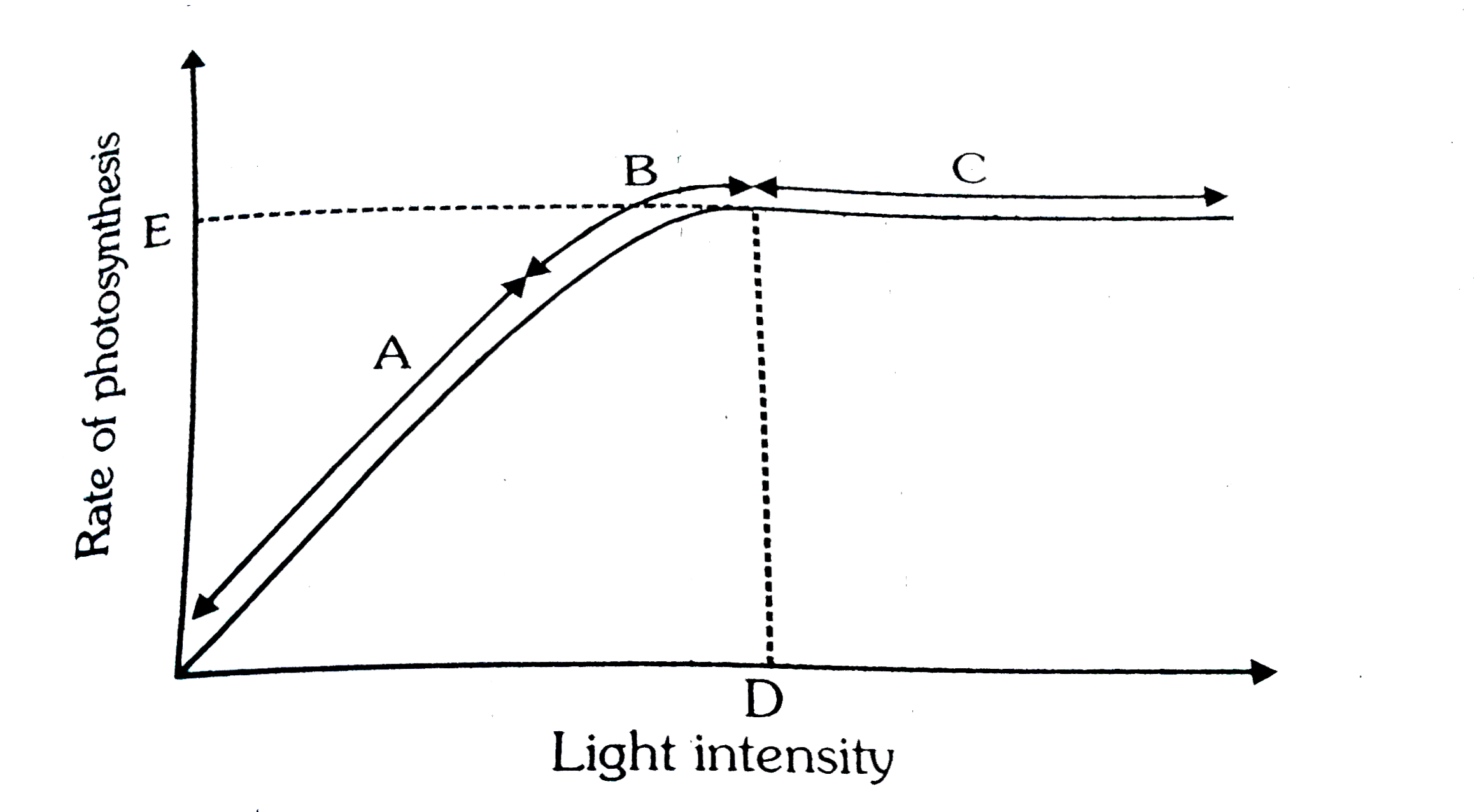Linear relationship exists between incident light and rate of CO2 fixation at/in.
High light intensity
Low light intensity
Dense forests
More than one option is correct
The correct Answer is:D
Step-by-Step Solution:
1. Understanding the Terms:
- Incident Light: This refers to the light that falls on the leaves of plants. It is crucial for the process of photosynthesis.
- Rate of CO₂ Fixation: This is the rate at which carbon dioxide is converted into organic compounds (like glucose) during photosynthesis.
2. Linear Relationship:
- A linear relationship means that as one variable changes, the other variable changes in a consistent manner. In this context, as the intensity of incident light increases, the rate of CO₂ fixation also increases, up to a certain point.
3. Role of Light in Photosynthesis:
- Photosynthesis requires light, carbon dioxide, and water. The chlorophyll in the leaves absorbs light energy, which is then used to convert CO₂ and water into glucose and oxygen.
- Higher light intensity generally increases the rate of photosynthesis, leading to higher CO₂ fixation.
4. Effects of Light Intensity:
- High Light Intensity: Increases the rate of photosynthesis and CO₂ fixation, but only to a certain extent. Beyond a certain light intensity, other factors may become limiting.
- Low Light Intensity: While it may not be optimal, there is still some level of CO₂ fixation occurring. The relationship remains linear but at a lower rate compared to high light intensity.
- Dense Forests: In dense forests, light penetration is reduced, leading to lower rates of photosynthesis and CO₂ fixation. This environment does not support a strong linear relationship due to insufficient light.
5. Conclusion:
- The linear relationship between incident light and the rate of CO₂ fixation can exist in both high and low light intensity environments. However, it is less effective in dense forests where light is limited.
Final Answer:
A linear relationship exists between incident light and the rate of CO₂ fixation primarily in low light intensity and high light intensity environments, but not effectively in dense forests.
---
- Incident Light: This refers to the light that falls on the leaves of plants. It is crucial for the process of photosynthesis.
- Rate of CO₂ Fixation: This is the rate at which carbon dioxide is converted into organic compounds (like glucose) during photosynthesis.
- A linear relationship means that as one variable changes, the other variable changes in a consistent manner. In this context, as the intensity of incident light increases, the rate of CO₂ fixation also increases, up to a certain point.
- Photosynthesis requires light, carbon dioxide, and water. The chlorophyll in the leaves absorbs light energy, which is then used to convert CO₂ and water into glucose and oxygen.
- Higher light intensity generally increases the rate of photosynthesis, leading to higher CO₂ fixation.
- High Light Intensity: Increases the rate of photosynthesis and CO₂ fixation, but only to a certain extent. Beyond a certain light intensity, other factors may become limiting.
- Low Light Intensity: While it may not be optimal, there is still some level of CO₂ fixation occurring. The relationship remains linear but at a lower rate compared to high light intensity.
- Dense Forests: In dense forests, light penetration is reduced, leading to lower rates of photosynthesis and CO₂ fixation. This environment does not support a strong linear relationship due to insufficient light.
- The linear relationship between incident light and the rate of CO₂ fixation can exist in both high and low light intensity environments. However, it is less effective in dense forests where light is limited.
A linear relationship exists between incident light and the rate of CO₂ fixation primarily in low light intensity and high light intensity environments, but not effectively in dense forests.
Topper's Solved these Questions
- PHOTOSYNTHESIS IN HIGHER PLANTS BOOK - AAKASH INSTITUTE ENGLISHCHAPTER - PHOTOSYNTHESIS IN HIGHER PLANTS EXERCISE - Assignment(Section B)
34 Videos
- PHOTOSYNTHESIS IN HIGHER PLANTS BOOK - AAKASH INSTITUTE ENGLISHCHAPTER - PHOTOSYNTHESIS IN HIGHER PLANTS EXERCISE - Assignment(Section C)
60 Videos
- PHOTOSYNTHESIS IN HIGHER PLANTS BOOK - AAKASH INSTITUTE ENGLISHCHAPTER - PHOTOSYNTHESIS IN HIGHER PLANTS EXERCISE - Exercise
30 Videos
- ORGANISMS AND POPULATIONS BOOK - AAKASH INSTITUTE ENGLISHCHAPTER - ORGANISMS AND POPULATIONS EXERCISE - ASSIGNMENT (SECTION-D) (Assertion-Reason Type Questions)
15 Videos
- PLANT GROWTH AND DEVELOPMENTBOOK - AAKASH INSTITUTE ENGLISHCHAPTER - PLANT GROWTH AND DEVELOPMENTEXERCISE - ASSIGNMENT (SECTION -D)
10 Videos
Similar Questions
Relationship between incident light and CO2 fixation rate is
View SolutionObserve the given graph carefully and choose the correct statements for labelled points, (A to E)
 Points:-
Points:-
(A)- There is a linear relationship between incident light and CO2 fixation rates.
(B)- It is a transition poit where limiting factor changes.
(C)- At this region light intensity is not showing detrimental effect on rate of photosynthesis.
(D)- It shows light saturation point sunlight except for plants in shade or in dense forests.
(E)- This point show maximum rate of photosynthesis at optimum presence of various parameters.
View SolutionThe diagonal relationship exists in between
View SolutionBulk CO2fixation occurs in
View SolutionWhich of the graphs shown below does not represent the relationship between incident light and the electron ejected from metal surface ?
View SolutionWhich of the graphs shown below does not represent the relationship between incident light and the electron ejected from metal surface?
View SolutionWhich of the graphs shown below does not represent the relationship between incident light and the electron ejected from metal surface?
View SolutionWrite a relationship between angle of incidence and angle of refraction for a given pair of media.
View SolutionSucculents perform CO2 fixation
View SolutionC4 pathway of CO2 fixation was discovered by
View Solution
